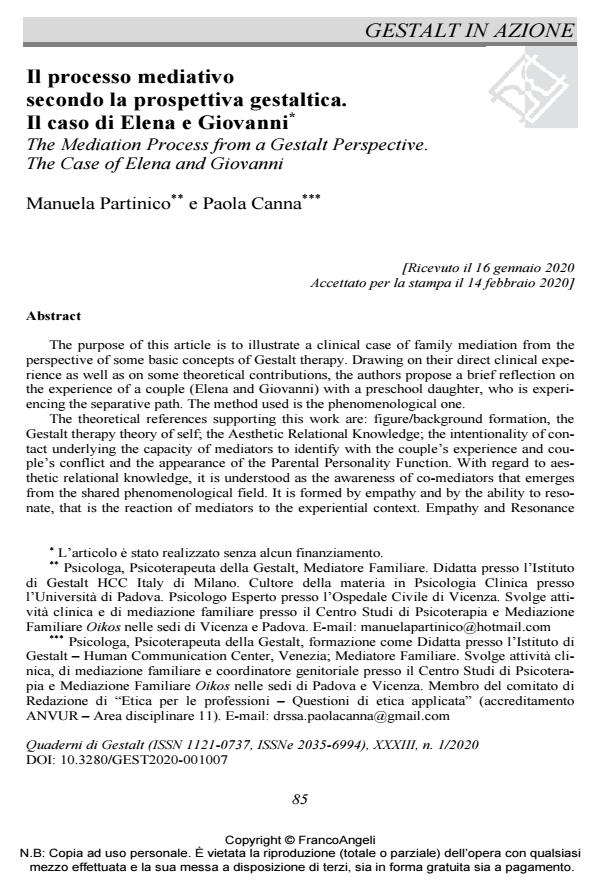The Mediation Process from a Gestalt Perspective. The Case of Elena and Giovanni
Journal title QUADERNI DI GESTALT
Author/s Manuela Partinico, Paola Canna
Publishing Year 2020 Issue 2020/1
Language Italian Pages 13 P. 85-97 File size 208 KB
DOI 10.3280/GEST2020-001007
DOI is like a bar code for intellectual property: to have more infomation
click here
Below, you can see the article first page
If you want to buy this article in PDF format, you can do it, following the instructions to buy download credits

FrancoAngeli is member of Publishers International Linking Association, Inc (PILA), a not-for-profit association which run the CrossRef service enabling links to and from online scholarly content.
The purpose of this article is to illustrate a clinical case of family mediation from the per-spective of some basic concepts of Gestalt therapy. Drawing on their direct clinical experience as well as on some theoretical contributions, the authors propose a brief reflection on the expe-rience of a couple (Elena and Giovanni) with a preschool daughter, who is experiencing the separative path. The method used is the phenomenological one. The theoretical references supporting this work are: figure/background formation, the Gestalt therapy theory of self; the Aesthetic Relational Knowledge; the intentionality of contact underlying the capacity of mediators to identify with the couple’s experience and couple’s con-flict and the appearance of the Parental Personality Function. With regard to aesthetic relational knowledge, it is understood as the awareness of co-mediators that emerges from the shared phenomenological field. It is formed by empathy and by the ability to resonate, that is the reaction of mediators to the experiential context. Empathy and Resonance are the two important tools which anable to understand Elena and Giovanni’s relational suffering. A main part of the work in the mediation process consists in giving support to the Parental Personality Function with the aim of replacing the reference framework "being husband/wife of" with that of "being father/mother of". To achieve this goal, it is essential to free up the space occupied by the cou-ple conflict in order to increase the issues related to parenting. According to the Gestalt perspective, Aesthetic Relational Knowledge is the premise from which to promote the couple’s "now-for-next". It is represented by the all-embracing experience of parenting, capable of restoring everyone’s sense of self that emerges from relational recognition.
Keywords: Gestalt family mediation, couple conflict, separation, parental personality function, relational recognition.
Manuela Partinico, Paola Canna, Il processo mediativo secondo la prospettiva gestaltica. Il caso di Elena e Giovanni in "QUADERNI DI GESTALT" 1/2020, pp 85-97, DOI: 10.3280/GEST2020-001007